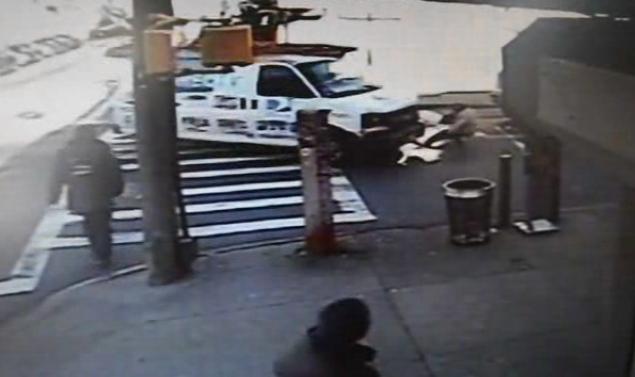
An unlicensed motorist who killed a senior in Brooklyn last year has pled guilty to a low-level misdemeanor and could be sentenced to probation and a nominal fine. Though the driver was charged with violating two traffic laws, current and former district attorneys Ken Thompson and Charles Hynes declined to pursue criminal negligence charges under the so-called "rule of two."
Maude Savage was in a crosswalk and crossing with the light at Sutter and Euclid Avenues on November 25 when Robert Brown drove a commercial van into her, according to reports. Video of the crash shows that Brown barely slowed as he turned left toward Savage, leaving her no time to clear his path. Savage soon died from her injuries. She was 72.
Brown was charged by then-DA Hynes with third degree aggravated unlicensed operation, a misdemeanor that stipulates that he drove without a license when he knew or should have known he didn’t have one. Court records say he was also ticketed for failure to yield to a pedestrian in a crosswalk. Charges against Brown were not upgraded after Maude Savage died.
The rule of two is case law precedent that holds that a New York State motorist who is breaking at least two traffic laws at the time of a crash may be charged with criminal negligence. New York City prosecutors reflexively cite the rule as an obstacle to charging motorists for killing, but routinely fail to bring charges in crashes involving two or more traffic violations. The circumstances of this crash -- driving without a license, failure to yield -- seemingly satisfied the rule of two, but neither Hynes nor his successor Thompson exercised it.
City prosecutors tend to pursue third degree unlicensed operation as the top charge against unlicensed drivers who kill pedestrians. (It's also applied against unlicensed drivers who turn without signaling.) Third degree unlicensed operation carries a maximum penalty of 30 days in jail and a $500 fine.
According to court records, on June 20 Brown pled guilty to unlicensed operation in the second degree, a charge that may be applied when a defendant is caught driving without a license after prior convictions for unlicensed driving, or when the defendant's license was previously suspended or revoked pursuant to a drug or alcohol related driving offense. Second degree unlicensed operation is a more serious charge, but it's still an unclassified misdemeanor. Penalties may include jail time, probation, and a fine of not less than $500.
Brown is scheduled to be sentenced in August.





